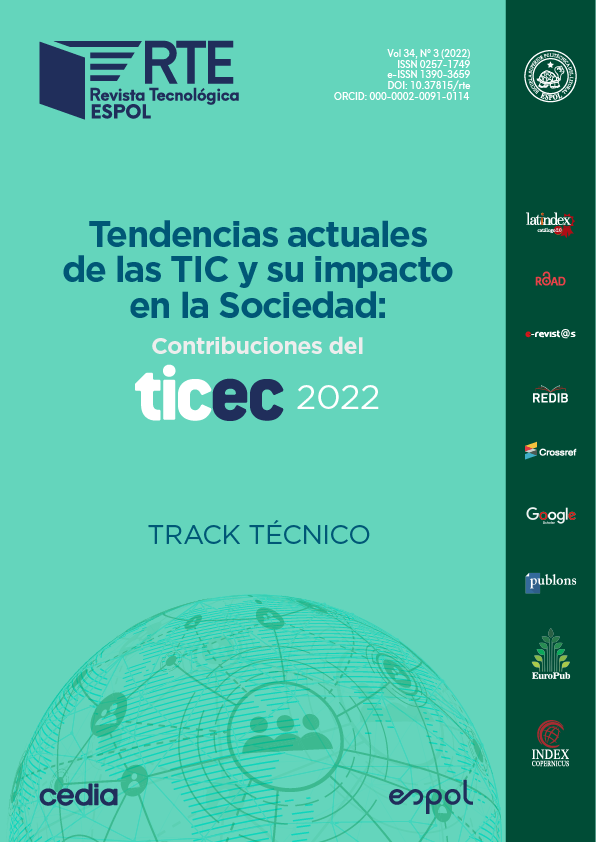La industrialización y el rápido crecimiento de zonas urbanas aumentan alarmantemente la presencia de contaminantes atmosféricos. Estos contaminantes afectan la calidad de vida de las personas y se crea una oportunidad de estudio para determinar su comportamiento atmosférico y la relación entre variables meteorológicas presentes en el ambiente. Previo a esto, se aplicaron ventanas rodantes de tiempo para eliminar datos anómalos. A continuación, se identificaron variables y se segmentaron los datos a través del algoritmo X-means. También, dos clústeres que representan las relaciones entre pares de variables y la temporalidad de las ventanas de tiempo. Como resultado, se encontró una correlación inversa de -0,78 entre las variables de ozono y punto de rocío dentro de las horas de la jornada laboral.

Esta obra está bajo una licencia internacional Creative Commons Atribución-NoComercial 4.0.
Referencias
Brook, R. D., Rajagopalan, S., Pope, C. A., Brook, J. R., Bhatnagar, A., Diez-Roux, A. V., Holguin, F., Hong, Y., Luepker, R. V., Mittleman, M. A., Peters, A., Siscovick, D., Smith, S. C., Whitsel, L., & Kaufman, J. D. (2010). Particulate matter air pollution and cardiovascular disease: An update to the scientific statement from the american heart association,. Circulation, 121(21), 2331–2378. https://doi.org/10.1161/CIR.0b013e3181dbece1
Chong, K. C., Lau, W. J., Lai, S. O., Thiam, H. S., & Ismail, A. F. (2019). Preparation and Characterization of Chromium Metal Organic Framework for Carbon Dioxide Adsorption. IOP Conference Series: Earth and Environmental Science, 268(1), 012010. https://doi.org/10.1088/1755-1315/268/1/012010
Clifford, A., Lang, L., Chen, R., Anstey, K. J., & Seaton, A. (2016). Exposure to air pollution and cognitive functioning across the life course—A systematic literature review. Environmental Research, 147, 383–398. https://doi.org/10.1016/j.envres.2016.01.018
Franchini, M., Mengoli, C., Cruciani, M., Bonfanti, C., & Mannucci, P. M. (2016). Association between particulate air pollution and venous thromboembolism: A systematic literature review. European Journal of Internal Medicine, 27, 10–13. https://doi.org/10.1016/j.ejim.2015.11.012
Fränti, P., & Sieranoja, S. (2018). K-means properties on six clustering benchmark datasets. Applied Intelligence, 48(12), 4743–4759. https://doi.org/10.1007/s10489-018-1238-7
Goel, A., Ray, S., Agrawal, P., & Chandra, N. (2012). Air Pollution Detection Based on Head Selection Clustering and Average Method from Wireless Sensor Network. 2012 Second International Conference on Advanced Computing Communication Technologies, 434–438. https://doi.org/10.1109/ACCT.2012.18
Gu, K., Qiao, J., & Lin, W. (2018). Recurrent Air Quality Predictor Based on Meteorology- and Pollution-Related Factors. IEEE Transactions on Industrial Informatics, 14(9), 3946–3955. https://doi.org/10.1109/TII.2018.2793950
Juneja, A., & Das, N. N. (2019). Big Data Quality Framework: Pre-Processing Data in Weather Monitoring Application. 2019 International Conference on Machine Learning, Big Data, Cloud and Parallel Computing (COMITCon), 559–563. https://doi.org/10.1109/COMITCon.2019.8862267
Kumar, P., & Krishan Wasan, S. (2010). Analysis of X-means and global k-means USING TUMOR classification. 2010 The 2nd International Conference on Computer and Automation Engineering (ICCAE), 5, 832–835. https://doi.org/10.1109/ICCAE.2010.5451883
Lan, Y., & Dai, Y. (2020). Urban Air Quality Prediction Based on Space-Time Optimization LSTM Model. 2020 3rd International Conference on Artificial Intelligence and Big Data (ICAIBD), 215–222. https://doi.org/10.1109/ICAIBD49809.2020.9137441
Lind, D. A., Marchal, W. G., & Wathen, S. A. (2012). Estadística aplicada a los negocios y a la economía (15th ed.). McGraw-Hill.
Murray, R. S., & Larry, J. S. (2009). Estadística (4th ed.).
Orellana, M., Lima, J.-F., & Cedillo, P. (2021). Discovering Patterns of Time Association Among Air Pollution and Meteorological Variables. In K. Arai (Ed.), Advances in Information and Communication (pp. 205–215). Springer International Publishing. https://doi.org/10.1007/978-3-030-73103-8_13
Ostadabbas, S., & Jafari, R. (2010). Spectral Spatio-Temporal template extraction from EEG signals. 2010 Annual International Conference of the IEEE Engineering in Medicine and Biology, 4678–4682. https://doi.org/10.1109/IEMBS.2010.5626411
Othman, Z. A., Ismail, N., & Latif, M. T. (2017). Association rules of temperature towards high and low ozone in putrajaya. 2017 6th International Conference on Electrical Engineering and Informatics (ICEEI), 1–5. https://doi.org/10.1109/ICEEI.2017.8312438
Othman, Z. A., Risdiyanto Ismail, N., Aziz Hamdan, A., & Mahmoud, S. (2016). KLANG VALLY RAINFALL FORECASTING MODEL USING TIME SERIES DATA MINING TECHNIQUE. 92, 8.
Parker, A. (1983). Contaminación del aire por la industria (1st ed.). Editorial Reverté. https://www.reverte.com/libro/contaminacion-del-aire-por-la-industria_91542/
Paulose, B., Sabitha, S., Punhani, R., & Sahani, I. (2018). Identification of Regions and Probable Health Risks Due to Air Pollution Using K-Mean Clustering Techniques. 2018 4th International Conference on Computational Intelligence Communication Technology (CICT), 1–6. https://doi.org/10.1109/CIACT.2018.8480232
Russell, S. J., & Norvig, P. (2003). Artificial intelligence: A modern approach (2nd ed.). Prentice Hall/Pearson Education.
Simioni, D., & United Nations (Eds.). (2003). Contaminación atmosférica y conciencia ciudadana. Naciones Unidas, CEPAL.
Yang, X., Tang, K., & Yao, X. (2009). The Minimum Redundancy – Maximum Relevance Approach to Building Sparse Support Vector Machines. In E. Corchado & H. Yin (Eds.), Intelligent Data Engineering and Automated Learning—IDEAL 2009 (pp. 184–190). Springer. https://doi.org/10.1007/978-3-642-04394-9_23
Yu, S. S., Chu, S. W., Wang, C. M., Chan, Y. K., & Chang, T. C. (2018). Two improved k-means algorithms. Applied Soft Computing Journal, 68, 747–755. https://doi.org/10.1016/j.asoc.2017.08.032
Zhang, X., Zhang, X., & Chen, X. (2017). Happiness in the air: How does a dirty sky affect mental health and subjective well-being? Journal of Environmental Economics and Management, 85, 81–94. https://doi.org/10.1016/j.jeem.2017.04.001







